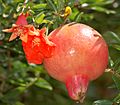Lythraceae facts for kids
Quick facts for kids Lythraceae |
|
|---|---|
 |
|
| Lythrum salicaria | |
| Scientific classification | |
| Kingdom: | |
| Division: | |
| Class: | |
| Order: | |
| Family: |
Lythraceae
J.St-Hil.
|
The Lythraceae is a family of flowering plants. It includes about 500 to 600 different kinds of plants. Most of these are herbs, which are plants with soft stems. Some are shrubs (bushy plants) and trees. There are 32 different groups, called genera, within this family.
Contents
What Makes Them Special?
Plants in the Lythraceae family are usually herbs. Sometimes, they are shrubs or trees. The shrubs and trees often have bark that peels off in thin layers.
Two main things help us know if a plant belongs to this family:
- Their petals are often crinkled or crumpled when they are still a bud.
- Their seeds have a special outer covering with many layers.
Leaves
The leaves of these plants are usually arranged in pairs, one across from the other. This is called an opposite arrangement. Sometimes, they grow in a circle around the stem, which is called whorled. Less often, they grow one after another along the stem, called alternate.
Their leaves are simple, meaning they are not divided into smaller leaflets. The edges of the leaves are smooth. The veins in the leaves look like a feather, with one main vein and smaller veins branching off it. This is called pinnate venation. Tiny leaf-like parts called stipules are usually very small or missing.
Flowers
The flowers of Lythraceae plants have both male and female parts. This means they are bisexual. They are usually round and even, like a star, which is called radially symmetric. Sometimes, they are more like a butterfly, with two matching halves, which is called bilaterally symmetric.
These flowers have a cup-shaped part called a hypanthium that holds the other flower parts. Most often, the flowers have four parts (like four sepals and four petals). But they can also have six parts. They usually have four to eight sepals and petals.
The sepals can be separate, partly joined into a tube, or just touching. The petals are crinkled when they are buds and stay wrinkled when they open. They are usually separate and overlap each other. Sometimes, there are no petals at all.
There are usually twice as many stamens (the male parts) as petals. These stamens are often different lengths. The ovary (the female part that holds the seeds) is usually above the other flower parts. Sometimes, it is partly below, or rarely, completely below. The flower has two to many carpels (parts that make up the ovary). These carpels can be joined together. Each part of the ovary can have many tiny future seeds, called ovules.
Some plants in this family have different types of flowers on the same plant. This is called heterostyly. It means the flowers have different lengths of their pistil (female part) and stamens (male parts). This helps with pollination.
Fruits and seeds
The fruit of these plants is usually a dry capsule that opens up to release the seeds. Sometimes, the fruit is a berry. The seeds are usually flat or have a wing-like shape. They have a special outer covering with many layers. About half of the plant groups in this family have tiny hairs on their seeds. These hairs expand and become sticky when they get wet.
Where They Grow
Lythraceae plants grow all over the world. Most species are found in warm, tropical areas. Some also grow in cooler, temperate regions. You won't find them in very dry places like the Sahara desert or most dry parts of Australia.
Many plants in this family like to grow in or near water. You can find them in aquatic (water) or semi-aquatic (partly water) places. Examples include Decodon, Didiplis, Rotala, Sonneratia, and Trapa.
Images for kids
See also
 In Spanish: Lythraceae para niños
In Spanish: Lythraceae para niños








